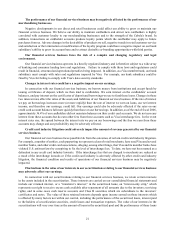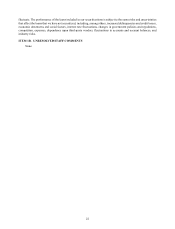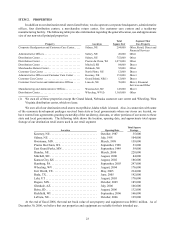Cabela's 2006 Annual Report Download - page 23
Download and view the complete annual report
Please find page 23 of the 2006 Cabela's annual report below. You can navigate through the pages in the report by either clicking on the pages listed below, or by using the keyword search tool below to find specific information within the annual report.19
Changes in these laws and regulations or additional regulation could cause the demand for and sales of our
products to decrease. Moreover, complying with increased or changed regulations could cause our operating expenses
to increase. This could adversely affect our revenue and profitability.
Our inability or failure to protect our intellectual property could have a negative impact on our operating
results.
Our trademarks, service marks, copyrights, patents, trade secrets, domain names and other intellectual property
are valuable assets that are critical to our success. Effective trademark and other intellectual property protection
may not be available in every country in which our products are made available. The unauthorized reproduction or
other misappropriation of our intellectual property could diminish the value of our brands or goodwill and cause a
decline in our revenue. Any infringement or other intellectual property claim made against us, whether or not it has
merit, could be time-consuming, result in costly litigation, cause product delays or require us to enter into royalty or
licensing agreements. As a result, any such claim could have an adverse effect on our operating results.
Failure to successfully integrate any business we acquire could have an adverse impact on our
profitability.
We may from time to time acquire businesses which we believe to be complementary to our business. Acquisitions
may result in difficulties in assimilating acquired companies and may result in the diversion of our capital and our
management’s attention from other business issues and opportunities. We may not be able to successfully integrate
operations that we acquire, including their personnel, financial systems, distribution, operations and general operating
procedures. If we fail to successfully integrate acquisitions, we could experience increased costs associated with
operating inefficiencies, which could have an adverse effect on our profitability.
Risks Related to Our Financial Services Business
We may experience limited availability of financing or variation in funding costs for our financial
services business, which could limit growth of the business and decrease our profitability.
Our financial services business requires a significant amount of cash to operate. These cash requirements will
increase if our credit card originations increase or if our cardholders’ balances or spending increase. Historically, we
have relied upon external financing sources to fund these operations, and we intend to continue to access external
sources to fund our growth. A number of factors such as our financial results, changes within our organization,
disruptions in the capital markets, our corporate and regulatory structure, interest rate fluctuations, general
economic conditions and accounting and regulatory changes and relations could make such financing more difficult
or impossible to obtain or more expensive.
We have been, and will continue to be, particularly reliant on funding from securitization transactions for
our financial services business. Securitization funding sources include both a commercial paper conduit facility
and fixed and floating rate term securitizations. Our commercial paper conduit facility renews annually in July.
A failure to renew this facility, to resecuritize the term securitizations as they mature or to add additional term
securitizations and commercial paper conduits on favorable terms as it becomes necessary could increase our
financing costs and potentially limit our ability to grow our financial services business. Unfavorable conditions in
the asset-backed securities markets generally, including the unavailability of commercial bank liquidity support or
credit enhancements, such as financial guaranty insurance, could have a similar effect.
Furthermore, even if we are able to securitize our credit card loans consistent with past practice, poor
performance of our securitized loans, including increased delinquencies and credit losses, lower payment rates or
a decrease in excess spreads below certain thresholds, could result in a downgrade or withdrawal of the ratings on
the outstanding securities issued in our securitization transactions, cause early amortization of these securities or
result in higher required credit enhancement levels. This could jeopardize our ability to complete other securitization
transactions on acceptable terms, decrease our liquidity and force us to rely on other potentially more expensive
funding sources, to the extent available, which would decrease our profitability.
























